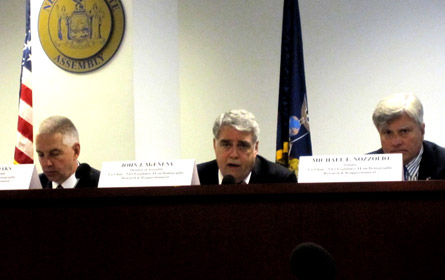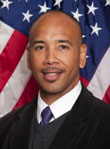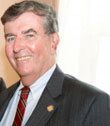Redistricting Battle Comes to a Head

Albany is hurtling toward a massive agreement that will likely resolve the state budget, create a new pension tier, expand the state’s DNA database and perhaps most notably finally resolve the long battle over the state district lines.
Late on Sunday night, just moments before midnight the legislature introduced their final proposal for Senate and Assembly district lines and an amendment that would change the process after the next census. On Monday U.S. Magistrate Judge Roanne Mann released her final proposal for Congressional districts—a proposal that would become law if the legislature fails to agree on their on plan—something they seem fated to do.
The battle lines were already drawn over redistricting earlier this year but now the major players have at least partially revealed their hands as negotiations continue between Gov. Andrew Cuomo and the legislature.
So who stands where? What do legislators have to gain? What does the Governor have to gain? What to good government groups have to gain and why can’t they all agree on a solution?
The Lines
The legislative majorities have submitted lines that most observers agree are only a miniscule improvement over their initial proposals that were hailed as blatant gerrymandering. Initially it was difficult for reporters to evaluate the new lines as LATFOR didn’t post maps on their homepage for quite some time after the legislation was introduced. A spokesman for the Senate Democrats eventually sent the maps to reporters with this statement, “Since the Senate Republicans are content on keeping the public in the dark and concealing the maps that they produced, we will do it for them. Attached you will find the maps which show very clearly that there is virtually no change from their previous proposal. These hyperpolitical maps cannot rationally be considered a better product.”
However, Gov. Andrew Cuomo said in a radio interview on Monday that his office worked with legislators on improving the initial lines. “They consulted with my people in redoing the lines,” Cuomo told Fred Dicker on Talk-1300. “The lines are far from perfect but I believe they made progress on the lines.”
Cuomo also insisted that he would veto the lines if the legislature does not agree to an amendment that would change the redistricting process when it occurs again more than a decade from now.
The final legislative proposal includes a 63rd Senate district which carves out rural parts of upstate New York—avoiding the edges of Democratic leaning cities like Albany and Schenectady in what is s seen as insurance for Senate Republicans. Without control of the district map most experts agree they would not be able to sustain much of a conference in the state because New York is such a heavily blue state.
The Amendment
At the heart of the disagreement between the legislative minorities and majorities and the major good government groups is the proposed legislative amendment and how it would alter redistricting a decade from now.
The amendment would establish a commission that would be made up of 2 legislative appointees from each legislative conference. The legislative appointees would then pick two more members—creating a 10-person panel.
The members of the commission would draw district lines and seven of them would have to vote to approve the legislative lines. Those lines would then have to be passed by the legislature.
According to the proposed legislation if the commission was unable to reach consensus on a plan the commission would be required to submit, “that plan (or plans, if two or more plans garnered an equal number of votes) that garnered the highest number of votes in support of its approval.”
The legislature would ultimately have to pass the commission’s lines. If the legislature rejects the commission’s plan twice in a row the legislature can make slight changes to the maps. A limit is set at a 2 percent deviation.
The Argument For
Two major good government groups have come out in support of the deal that would allow the legislature to go forward with their lines as long as they pass they agree to a constitutional amendment and a failsafe that would enact the changes should two successive legislatures fail to pass the amendment.
Citizens Union and League of Women Voters New York support for the deal is admittedly pragmatic. (Gotham Gazette is published by Citizens Union Foundation the sister organization of Citizens Union. ) They admit that their efforts earlier this year—that lead to 184 legislators signing a pledge to enact a non-partisan redistricting commission –have basically failed. They insist that Cuomo should go ahead with the agreement because this is a rare opportunity for him to force the legislature to enact changes to the process as a whole. “We are not going to trust them again,” said Dick Dadey executive director of Citizens Union, “the promise of let the court draw the lines and we are going to reform the process next time around. They haven’t done it and they never going to do it until they are backed into the corner like they are now.”
During a press call hours after the amendment was released Dadey told reporters:
"Citizens Union's approach to good government isn't just about taking positions, critiquing the actions of government officials and pushing an agenda," said Dadey. "We want to be both principled yet pragmatic and try and actually achieve the solutions that we set out to address."
Citizens Union and League of Women Voters have not offered steadfast defense of some of the qualities of the amendment when questioned by reporters. When asked why the bill allows commission members to be family members, or business partners with legislators Dadey responded that such restriction would “limit the pool” of candidates. Adding, “Another thing is, simply because you're the brother of a legislator doesn't mean you're going to agree with him or her on these issues.”
Argument Against
Common Cause, New York Public Interest Group as well as former Mayor Ed Koch, the man who lead the pledge drive during the 2010 elections, opposes the deal—as does the Senate Majority and a number of Assembly members.
They say that if the governor vetoes the legislature’s lines and puts them in the hands of the court New York could wind up with significantly improved maps. They point to the maps Congressional maps proposed by Judge Mann. Common Cause has created their own maps and feel that they could provide as a guide to the judge that was tasked with drawing the lines should Cuomo veto.
But they also have major concerns about the amendment itself. Common Cause said in a statement that
“The proposed Constitutional Amendment is a far cry from independent redistricting, with final approval of the maps squarely in the hands of the legislature. “ This is not reform let alone even an improvement. This is change for change's sake.”
Further more they point out that the criteria for drawing districts favors incumbency over criteria such as “communities of interest.”
“Incumbency, in coded language, is given primacy,” Common Cause’s statement reads, “and there is no mention of prison based gerrymandering. In stark contrast, the proposed criteria devised in the 1967 constitutional convention states simply: "Gerrymandering for any purpose is prohibited" (Section 2, subsection c).
In order to achieve meaningful reform in the future, and for the next ten years, the Governor must hold firm to his promise to veto any politicized maps, and work toward a solid constitutional amendment which truly reforms the redistricting process.”
What’s Next?
With Albany hurtling towards the next “Big Ugly” it seems that a deal could be reached at any time. Cuomo’s move—to veto or not to veto could be weighted heavily by deals made on other issues such as Tier 6 and the budget. On March 15 judicial panel will review Mann’s lines unless the legislature comes to an agreement on Congressional lines.
Redistricting Hearings Draw Stream of Objections

In a series of hearings across New York City last week, lawmakers, special interest groups, community organizations and private citizens blasted Senate and Assembly redistricting proposals put out by the Legislative Task Force on Demographic Research and Reapportionment (LATFOR), sometimes using words like “embarrassing” and “abomination.”
Most complaints involved the Senate lines, though the Assembly lines got some attention. Hearing attendants described concerns about splitting up communities, diluting minority votes and gerrymandering districts in order to make it easier for senate Republicans to win.
Governor Andrew Cuomo called the proposed districts “unacceptable” and vowed to veto them. Many democratic lawmakers and dissatisfied groups are pushing for the veto and would prefer to entrust redistricting to the federal courts. Over 100 people testified in Queens and over 50 testified in the Bronx.
“This is the worst gerrymandering in the history of New York State,” said Sen. Michael Gianaris who represents Northwestern Queens. Under the proposal, Gianaris’s Astoria-dominated district has been split, pitting him against fellow Democrat and friend, Sen. Jose Peralta, a pattern that occurred in four senate districts.
Gianaris complained that under the proposal, the Latino-heavy Suffolk county will be split into three districts, undermining the Latino vote. He added that Westchester, where three cities will be grouped into one district and Rochester where one city is being split into three districts, will face the same problem of minority disenfranchisement.
He also gave Hempstead as an example, where an African-American population will be split among four districts, “All represented by white men – this in a town that has African-American representation in the assembly and two African-Americans in the County legislature.”
The National Association for the Advancement of Colored People and the Southeast Queens Community Coalition for Civil Rights also protested against what they called disproportionate white representation of minority communities. Garth Marshant, president of the Southeast Queens coalition, said that it’s wrong that two thirds of Queens is represented by white men while Queens County is only 39 percent white, according to 2010 Census figures.
Assemblyman John “Jack” McEneny, the co-chair of LATFOR, countered that the task force does not look at the race of elected officials and that it’s his understanding that many legislators capably represent constituents of a different race than they are. “That’s pretty racist” to suggest otherwise, he said.
Bronx residents were similarly incensed that Bronx’s community board 7 remains split among three different assembly districts. Residents of Norwood complained that the neighborhood would be split between the 33rd and 34th senate districts. Don Bluestone, executive director at Mosholu Montefiore Community Center said that Norwood’s voice is small as is and to further reduce it would be “devastating.”
One of the loudest voices to speak out against redistricting came from Eastern Queens United, a coalition of community leaders from Glen Oaks, Floral Park, New Hyde Park, Bellerose, and Queens Village who opposed splitting Eastern Queens among ethnic lines.
“The lines are an abomination. They were drawn specifically to serve the interests of politicians and political parties, not the voters and communities,” said Bob Friedrich, the group’s founder. “LATFOR completely ignored our requests and divided our community into unidentifiable blobs on a map. The borders run along not natural boundaries but along small, residential streets.”
But Eastern Queens United opponents, the Asian American Legal Defense and Education Fund, who pushed for a majority Asian community in Eastern Queens that would include part of Long Island, are also not entirely happy. Jerry Vattamala, a lawyer for the fund, who testified in Queens, said that Flushing and Bayside are insufficiently integrated as an assembly district and that Bay Terrace needs to be removed. He also said that Richmond Hill and South Ozone Park remain divided among many assembly districts.
However, Vattamala said, AALDEF is more pleased with assembly districts 49, 47, 40 and 25. “At least they gave us something,” he said, adding that the group will continue to fight for an improved version of the redistricting proposal.
McEneny said that most concerns LATFOR heard so far in New York City center around splitting ethnic communities and neighborhoods that wish to remain together, moreso than considerations about the advantages of political parties. He said that the task force is already looking at ways to improve on its proposal and take public concerns into account.
However, he said, that sometimes LATFOR’s options are limited due to the complexity of district partitions and the Voting Rights Act of 1965. Among other provisions, the act mandates that communities with over 50 percent minority populations must be grouped together.
“You can’t change one district line without changing another district. Whatever you put in, you have to take out,” said McEneny. “If the part you put out goes to a Voting Rights act district, what happens to their neighbors?”
Governor Cuomo’s veto threat hangs over the proposal which Gianaris called “DOA.” Peralta said that he is confident that the federal court, which would have to take over in case of a veto, would to a “better and faster” job than LATFOR, something many of the redistricting opponents agreed with.
McEneny disagreed and quoted the Governor’s earlier statement that bringing in the federal court would cause “chaos” as there is less understanding of local community concerns at the federal level.
Not everyone came to the hearings to complain. Maf Misbah Uddin, a Jamaica resident and president of the New York Central Labor Council praised the new assembly district 24, saying “this is the first time there is a South Asian dominated district. South Asians can finally come together.” Miguel Rordiguez, a business owner from Corona offered words of support for the overlooked congressional districts, saying that Dominicans in Northern Manhattan and the Bronx would have better nationwide representation under the plan.
But most people remain dissatisfied and do not appear to show much faith in LATFOR.
“There’s all kinds of contradictions and a human being has to make a decision. When a line is drawn, someone will always cry foul and someone else will stay silent. It goes with the territory,” said McEneny.
Top Stories of 2011
A number of our pundits made some big bets last year, pushing all their chips into the center of the table, only to see them swept up by the dealer. Perhaps the best example of gambling on the wrong outcome was Sen. Ruben Diaz, Sr., whose prediction was short and to the point.
"There will be a fight in the senate for gay marriage and it will fail to pass again. So my prediction is there will be no gay marriage in 2011," Diaz told us by phone from his holiday party last year. There was a fight in the Senate but little did Diaz know that Gov. Andrew Cuomo would craft a deal with both sides of the aisle, a deal that saw same-sex marriage become the law of the land. It doesn’t seem many people knew the kind of political force Albany was dealing with before Cuomo took the reins of power in 2011.
Going with his heart over his better judgment, Terry O’Neill, founder of the Constantine Institute, misread the cards for his friend Albany County District Attorney David Soares and said he expected, “Andrew Cuomo to appoint Albany County D.A. David Soares as commissioner of criminal justice services.” Soares very publically earned the ire of the Cuomo administration this year when he refused to prosecute peaceful protestors at Occupy Albany.
Roberto Perez, keeper of The Perez Notes Blog, nearly hit the nail on the head last year when he predicted embattled NYC Schools Chancellor Cathie Black would resign. But he sacrificed a safe bet for the sake of snark by adding that Black would join, "the Cuomo administration, after realizing that there is more dysfunction within the New York City school system than there is in Albany."
That isn’t to say no one got it right. A number of our pundits foresaw, as BronxTalk host Gary Axelbank put it, "The bloom will come off the rose or, more accurately, the rose will come off the bloom as the truth will begin to emerge about the Bloomberg administration." Whether the "truth" emerged or not, Axelbank wasn’t alone in foretelling the declining popularity of the Bloomberg administration through missteps and scandal during 2011.
Perhaps the most telling comments came from John Petro of the Drum Major Institute. Petro focused on the income disparity in the city, foreshadowing the major rallying cry of Occupy Wall Street. "In the city, where the wealthiest one percent takes home 44 percent of all income, the gap between the rich and the poor will widen. Jobs will be created, but largely in low-paying sectors like retail and home health care. No one will point out the obvious: a $7.25 minimum wage is completely insufficient for New York City." Petro got it wrong, however, when he predicted that the living wage bill would pass the Council. That is a battle that will continue to play out in 2012.
Who would our political pundits put their money on in 2012, what trends will pay off, what is a sure bet for the new year? What would make a good parlay? Read on dear reader, our political tip sheet is yours to peruse.
Once the weather warms up, I think we're going to see a huge surge in activity from the Occupy Wall Street movement. My prediction is that by working together with elected officials, OWS will influence the budget process. Organizing with thousands of city residents, the movement will stop the Mayor's pattern of balancing the budget on the backs of working and middle class New Yorkers. Apart from Occupy Wall Street, I also predict that State Senator Adriano Espaillat will soon be changing his title to Congressman Adriano Espaillat, taking his long history of great work for Northern Manhattan and the Bronx to Washington, D.C."
With tough budget decisions ahead in 2012 our office will maintain its focus on paring dollars from unnecessary outside contracting, saving pension cost with investment reforms, and finding waste with thorough auditing of city agencies.
1. The Mayor will wake up sometime near the middle of the year and say, "Wait, you mean I'm the Mayor of the entire NYC and not just the 1%? Why didn't anyone tell me?”
2. My favorite sports team, the Knicks, will continue to trade for the oldest and most injured among us.

Bronx Borough President Ruben Diaz Jr.
This year, we have taken major steps to market The Bronx, attract new businesses, support our existing businesses, and grow the overall economy of our borough, and in the coming year my office will continue fighting for the economic development of our borough. Although we face challenges in our education, economy, among other things, it is time to let the world know once again that the Bronx is a place of success. In addition I, along with all 1.4 million Bronxites, have World Series number 28 in sight this new year and feel confident that our Bronx Bombers will repeat their 2009 performance.
Gene Russianoff, NYPIRG Straphangers Campaign
1. Sadly, the fare will go up at the end of 2012. That's the MTA plan. Last time, in December 2010, the 30-day unlimited MetroCard went up 17%. If that happens again – and there are fare hikes, as planned, for every two years – be prepared for a $167 30-day card in 2017. A good time to be in the 1%.
2. There will be some good news for long-suffering bus riders: You will soon be able to use your cell or smart phone to tell how far your bus is from your stop in real time. A new "Bus Time" program goes Staten Island-wide in January 2012--and then around the city.
3. "Poetry in Motion" – subway car ads featuring works from Shakespeare to Frost – will return from retirement. You may get stuck in a subway tunnel, but it will be your chance to catch up on the likes of Langston Hughes or Emily Dickinson.
Colin Campbell keeper of The Brooklyn Politics and reporter for The Politicker.
1. All hope for independent redistricting will turn out to be mere naive wishfulness -- redistricting will be just as partisan next year as it's always been.
2. Andrew Cuomo will schedule the special election to replace former State Senator Carl Kruger this Spring, and the race between Democratic Councilman Lew Fidler and Republican attorney David Storobin will be a close one, won by single digits (I'm clueless as to who will win it though!)
3. The Republicans will draw a new majority-Asian State Senate district in Queens. While they'll have a shot at winning it if Republican Councilman Peter Koo runs, the more important reason for drawing this district will be to provide the argument that the Republican map better protects minority representation when the inevitable lawsuits come a knockin'.
4. Mitt Romney wins New York's Republican primary next April. This is a pretty easy prediction so I can say I got at least one right should the other ones go awry haha.
The new ethics law required the Board of Elections to establish new rules for the disclosure of independent expenditures on state races by January 1st. The Board will start the year off on the wrong foot by failing to meet this deadline. Two weeks later, the January filings will reveal that hundreds of donors gave more than the legal limit in 2011. The Board will take no action. They will also fail to do anything when these filings reveal that several elected officials used their campaign coffers for personal purposes, such as funding their legal defenses.

I predict we will have really good legislation coming out of the Council. Two bills I look forward to having hearings on involve street vendors. They receive thousand dollar fines for minimal violations. Hopefully it will come to a vote. Small things like having their cart over a subway grate, or not properly displaying their license can get them a thousand dollar fine, and these guys only make $15,000 a year. It is outrageous.
I predict the governor follows through on his commitment to veto LATFOR’s lines if they don’t meet independent standards.
I hope the Governor will make as passionate a commitment to moving on public financing of elections as he did to same-sex marriage last year.
I was told my official response should be that I will run [for mayor] if I am drafted, and up until this point it has been working.
Barbara Bartoletti League of Women voters
I predict Gov. Andrew Cuomo will have yet another session that by his terms will be successful. It might not be successful by our terms, but he will have a successful session one way or another.

Deputy Minority Leader Sen. Neil Breslin
I have two predictions—the courts will decide the lines and give us fair redistricting maps and the N.Y. Giants will win the Super Bowl
I predict... I will have several new Democratic colleagues in the New York State Senate.
I predict... We will pass a real health exchange for the state of New York.
I predict... The Occupy Wall Street movement will stay strong and continue to influence national dialogue on issues of economic inequality.
Barbara Bartoletti League of Women voters
I predict Gov. Andrew Cuomo will have yet another session that by his terms will be successful. It might not be successful by our terms, but he will have a successful session one way or another.
Adam Lisberg, editor City & State
At the risk of looking like more of a fool than usual twelve months from now, here are a few thoughts on the year to come. Despite all the turmoil and change of the last year, the one common theme is I expect the status quo to stay the status quo:
- The mayoral race will stay largely quiet. Just as the rumors always swirl about a business-backed would-be Bloomberg jumping in as a Republican, rumors will also swirl about a black or Latino challenger to try to undercut Bill Thompson among Democrat primary voters. Neither will happen. The existing major candidates have worked too hard, scrubbed their records too clean and raised too much money to let an interloper disturb their grim dance. You will hear names popping up. Don't waste your time worrying too much about them.
- Comptroller John Liu will still be comptroller. And since he's never officially declared for mayor, he has no reason to drop out, despite the growing federal probe into his fundraising. His chances will shrink, not because he really fears the feds, but because the institutional and union supporters he needs will shy away from investing in a candidate with a target on his back. Liu is too single-minded and ambitious to rule out anything in his future just because the feds have a target on his back and are trying to get underlings to flip on him. Unless Manhattan U.S. Attorney Preet Bharara caught Liu on a wiretap directing illegal fundraising in his own words, he is unlikely to get indicted. And I believe Liu is too smart to have done that.
- Gov. Andrew Cuomo will not fall to earth. He is too skilled a politician to believe his own press, and is too focused on the mechanics of governing to let his attention wander. He knows there are forces that hope he settles into a sophomore slump, so he will stay focused on getting results and keeping on top of every potential threat. Beginner's luck wears off, but he knows the finish line wasn't the budget, the tax deal or gay marriage -- it will be New York's economy and job market in 2014. Or 2016.
- New York's media will stay robust and vibrant, even as more and more New Yorkers shift from reading newspapers and watching TV. A new iPad model and other competing tablets will give more people a reason to get their news in mobile form, not in an old format they have to buy every morning or sit down to watch. Yet the profusion of emerging sources of credible and interesting media will continue to grow -- as Capital New York did, and BuzzFeed might, and other startups dream of -- giving everyone in New York an explosion of good options. That's good news for new media outlets, bad news for old media empires, and scary news for journalists who hope to one day have an employer that contributes to their 401(k).
John Petro, Drum Major Institute
Wall Street bankers may have breathed a sigh of relief upon the clearing of Zuccotti Park, but as warm weather returns to New York the Occupy movement--or some new variation of it--will once again take to the streets of New York City and the capitol to shed light on worsening inequality and the indefensible concentration of wealth among the state's wealthiest. New mass protests in 2012--routinely numbering in the tens of thousands--will dwarf this past Autumn's marches in Lower Manhattan, and Democrats all across the country will benefit from the national attention on issues of inequality, economic justice, and fairness.
With the passage of gay marriage last year, the city's stop and frisk policy will become the new prominent social justice issue in New York. Calls for a federal probe into New York City's unjust stop and frisk policy will intensify, though it is unclear whether the the U.S. Attorney General will actually undertake such an investigation. However, the increased scrutiny of the policy will put pressure on 2013 mayoral contenders to take a position on street stops.
New York City's living wage bill will be passed and promptly vetoed by Mayor Bloomberg. The City Council will then overturn this veto.
The state's minimum wage will get a boost later this year, with a higher wage set for New York City (San Francisco has a minimum wage of $10.24, New York City's is $7.25). This new wage will be indexed to inflation.
New housing construction will pick up in New York City by the middle of 2012, as the surplus of new condo units begins to dry up. Developers will begin to draw up plans for new residential towers, but the lack of financing will continue to be a problem.
Governor Cuomo will back down on his calls for independent redistricting as lawmakers draw up their own new maps.
The "fast-tracked" Tappan Zee bridge will come to a halt as concerned citizens rightly introduce lawsuits intended to ensure that mass transit is an integral part of the new bridge. In the end, federal grant money may appear to help make mass transit on the Tappan Zee a reality, once again making Cuomo look like a winner.
Finally, with the MTA set to lose about $320 million in revenue due to the partial repeal of the payroll mobility tax, congestion pricing will again emerge as a smart solution to funding the region's vital mass transit system. Governor Cuomo will drive to the capitol in one of his muscle cars to sign the bill allowing the city to set up a congestion zone.





